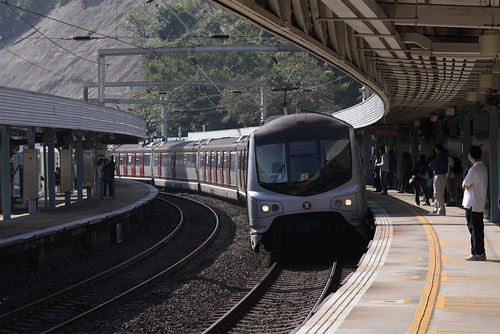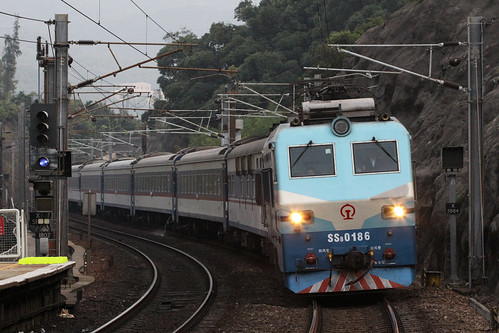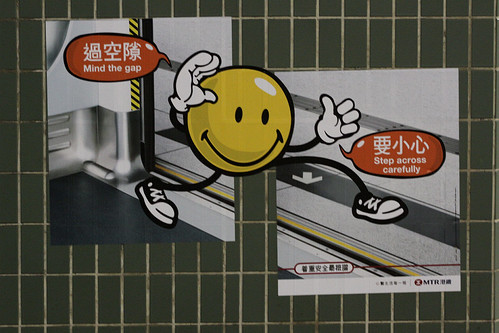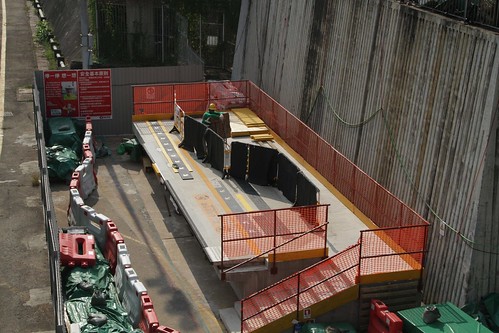The East Rail line has the widest gaps between train and platform on the MTR network, the route having opened to passengers in 1910 as the Kowloon-Canton Railway. In the years that followed and the system modernised, with attempts made to improve passenger safety – platform gap fillers having been tried and failed.
The problem
The East Rail line was built as a ‘main line’ railway, with curved platforms at seven of its 14 stations due to geographical constraints, and is served by a variety of trains – two type of MTR EMU and a variety of locomotives hauling Intercity Through Trains.
Curved platforms such as University and Mong Kok East have the widest platform gaps – 25 cm and 20 cm respectively.
Warning signs have been tried at stations.
On train doors.
And on the platform surface.
But passengers still fall into the gaps – a total of 283 accidents involving platform gaps occurred between 2013 and 2014 – about 12 per month on average
Enter platform gap fillers
Platform gap fillers are mechanical devices that move towards a stopped train to close the gap, then retract before departure to provide enough clearance for a train to pass.
In 2007 the pre-merger Kowloon–Canton Railway Corporation made the decision to trial mechanical gap fillers (MGFs) at Lo Wu station in real world conditions, in three phases:
- Phase 1: A 7-day test on two MGFs under manual control at the south ends of Platforms 3 and 4, completed in August 2008.
- Phase 2: A 6-week test on 10 MGFs under automatic control at Platforms 3 and 4, completed in May 2009.
- Phase 3: An 8-week test on 98 MGFs under automatic control at all four platforms with wide platform gaps, completed in October 2009.
But the Railways Inspectorate of the Hong Kong Government found the fillers unreliable:
Results of the trial indicated that the MGF system was not reliable during typhoon and inclement weather, and some MGFs were jammed during heavy rain by debris washed by rain water into the MGF mechanism. Results from data collected during the good weather days were also not too promising for reasons below:
(a) Poor availability: The availability of the MGF system was 99.83% only, which was lower than MTRCL’s target of 99.99%. A total of 17 failures were found in 10,000 operating cycles.
(b) Poor reliability: The reliability of the MGF system was found to be 30 times below target. The actual result was a fault every 9,601 cycles, compared to MTRCL’s target of once every 300,000 cycles.
(c) High failure rate: During the trial, 6.1 failures occurred each day. In addition, there were 42 cases of MGF faults requiring resetting/adjusting of MGF by staff, 34 cases of man-machine interface faults requiring staff attention, and 187 cases of signalling/train interface faults.
The cause of further safety issues.
Regular MTR passengers would be expecting MGFs to be available and not pay heed to the platform gap. As such, when a MGF fails to function, it would be a safety hazard for passengers with an increased risk of stepping into the platform gap.
And delayed trains.
We found that with the adoption of MGF, each station was required to incur an extra 15 seconds for each cycle of train door opening and closing due to limitations of the existing East Rail line signalling system. The impact was equivalent to a reduction of two train journeys per hour per direction during peak hours.
According to the results of a passenger survey conducted by the MTR in November 2009, of 1,735 passengers interviewed, 62% said that they would not accept a reduction of 2 train journeys per hour to accommodate installation of MGFs as they do not want to wait longer for trains.
Their eventual finding.
The trial was considered not successful as the MGF system was proved unreliable with prolonged platform dwell time and negative impact on service. MTRCL would therefore explore better solutions to mitigate the platform gap risk.
So what next?
Given the failed trial of platform gap fillers at Lo Wu, the decision was made to combine the required upgrades with the Shatin to Central Link project, which is bringing automatic platform gates, new signalling and new trains to the East Rail line.
A total of 2300 automatic platform gates will be installed across all platforms on the upgraded line, along with 140 gap fillers to be installed at Lo Wu, University and Mong Kok East Stations, where the platforms have the widest gaps.
In 2013 a mockup station platform was constructed in the Shatin Freight Yard to test the retrofitting process.
With work underway levelling and reinforcing platforms for the new infrastructure to rest atop them.
But the platform gates and gap fillers themselves cannot be commissioned until the completion of the Shatin to Central Link sometime after 2020, due to the existing train fleet not being compatible with the new infrastructure.
Sources
- Application of Automatic Platform Gates to reduce safety risks (October 2015 – Railways Branch, Electrical and Mechanical Services Department)
- Background brief on retrofitting of automatic platform gates along the East Rail Line and Ma On Shan Line (November 2013 – Legislative Council)
- Platform screen doors and automatic platform gates in MTR stations (March 2010, Legislative Council)
- Retrofitting of Automatic Platform Gates on the East Rail Line (January 2011, MTR Corporation)
- Shatin to Central Link Contract 1154B (2015, MTR Corporation)
- MTR Projects Journal, Issue 4 (September 2014)










In the UK, some trains are fitted with retracting steps, such as the Class 390 Pendolinos. I’m guessing from what is documented here and from my own personal experience on riding the East Rail Line that retrofitting these onto the MLR stock would not be feasible.
Found a video of them here:
I assume they’d be hard to retrofit to existing trains because you need space beneath the floor to fit the mechanism.
The shorter trains also mean that trains will stop at the less curved sections of the platform where possible.
I wonder how much curve they’ve be able to get rid of by going down to a nine car long train – Kowloon Tong station only has a curve at the south end, but both Mong Kok East and University seem to be curved through the entire platform.
Auckland uses platform gap fillers.
Interestingly their gap fillers are attached to the train, not the platform.
http://brizcommuter.blogspot.com/2017/01/brizcommuter-becomes-aucklandcommuter.html